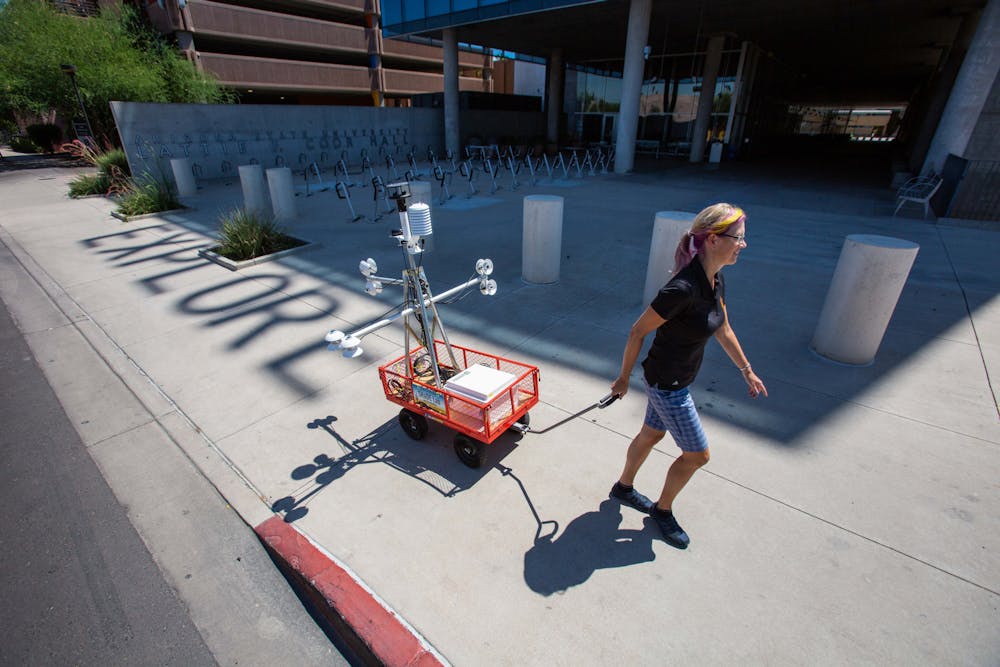Hosting an internationally diverse group of scientists and researchers, the SHaDe Lab at ASU is hoping to make the rising summer heat more bearable, not just for the Valley, but for the entire world.
The Sensible Heatscapes and Digital Environments (SHaDe) Lab is an innovative research facility dedicated to understanding and mitigating the impact of heat, particularly in urban environments. With a multidisciplinary team, the lab integrates geography, computer science, sustainability and engineering to create practical solutions for heat-related challenges.
"Here at the SHaDe lab, most of our research is focused on heat. We look at heat from three different dimensions," Ariane Middel, associate professor at ASU's School of Computing and Augmented Intelligence and a senior global futures scientist at the Julie Ann Wrigley Global Futures Laboratory, said. "We look at how people experience heat and, in the summer, here in Phoenix and elsewhere, how you can model heat using computer simulations."
This comprehensive approach is especially critical as heat waves become more intense and frequent due to climate change.
The SHaDe Lab houses a variety of innovative projects, each contributing uniquely to the understanding of urban heat and its management.
"There are very diverse projects and you can put them in buckets, (such as) heat sensing, heat modeling, and people's experience on the heat sensing side," said Middel. "We just finished a project with the city of Phoenix where we looked at the impact of cool pavement on temperatures here in Phoenix."
Complementing these efforts, the lab's modeling projects are of equal importance and scope. They are working towards shade distribution models for the entire Valley, which are being utilized by a student group to develop a thermal comfort routing app. Progress is well underway for their thermal comfort routing application, which is nearing completion.
"We can enable students and faculty to be safe in the heat," said Evan Crabtree, a graduate student working in the SHaDe lab. "It's just in general, viewing the hot topic of heat and how we can sense it, how it's experienced, and how we can model it to better our safety."
Accessibility is a priority, reflecting the SHaDe Lab's dedication to not only advancing research but also providing tangible, user-friendly solutions to the broader community.
"It (will be) deployed as a website," said Crabtree. "Anyone can … go to that website and be able to route appropriately using our tools. It should be free and accessible to everyone."
Another related project is the SHaDe tool. This innovative tool is currently being developed by the SHaDe Lab, focusing on how different types of shade can mitigate the effects of heat in urban environments.
"(It) basically assesses how ... a shade structure like a tree or an umbrella could impact a spot (and) the heat experience of a person around the year here in Phoenix," said Gisel Guzman, a graduate research assistant at the SHaDe lab.
Data collection for the SHaDe tool is meticulous and involves direct human interaction.
"The idea is going to be doing measurements on human subjects," said Guzman. "I'm gonna put sensors in the houses of people and … I'm going to have personalized surveys that are going to be applied to people in momentary assessments."
This project will explore a person's feelings when exposed to different environments and how that affects their everyday life.
The SHaDe Lab is not just limited to the Valley. It has an international reach, with its unique instrument, MaRTy, being used for weather data collection by research groups around the world.
"The MaRTy concept has been adopted by other research groups around the world," Middel said. "There is a cousin of MaRTy at UNSW in Sydney, Australia. There is a MaRTy in Guelph in Canada at the University of Guelph. We have a MaRTy in Singapore ... There's a MaRTy in Serbia … they would like to build a MaRTy in Spain."
This international collaboration enables the comparison of data across different climates, enriching the lab's research.
The SHaDE lab boasts a diverse and international team of students and researchers from various backgrounds, fostering a creative and inclusive environment. Beyond that, the lab also emphasizes the importance of getting to know each other beyond just research — an approach that not only strengthens team dynamics but also aids in identifying unique skills each member brings to the table.
"Our lab meetings really help with bringing people together," said Middel. "We have lab meetings every Friday. Last semester, we did a food series and the semester before too, because we were all from different countries. So every week, a student brings some snacks or some food from their home country."
These meetings provide an opportunity for members to share their cultures and bond over shared experiences, creating a nurturing environment conducive to innovation and teamwork.
As for future developments, the lab is continuing their work on the thermal comfort routing system and shade tool, with both expected to be available to the public soon.
"For the thermal comfort routing, we hope to have something that can be used by the public by the end of the semester … for the shade tool, (around) the same timeline" said Middel.
The SHaDe Lab is at the forefront of urban climate research, blending science and practical application to address the pressing issue of heat in urban environments. With its innovative approach and commitment to interdisciplinary collaboration, the lab is poised to make significant contributions to the field and improve the quality of life in heat-affected urban areas.
Edited by River Graziano, Sadie Buggle and Grace Copperthite.
Reach the reporter at dmanatou@asu.edu.
Like The State Press on Facebook and follow @statepress on X.
Dimitra is a junior studying biomedical engineering and physics. This is her second semester with The State Press. She has also worked as a research assistant in Kirian Lab.




